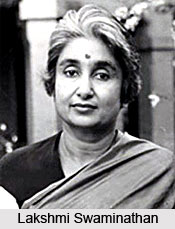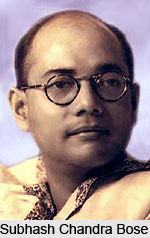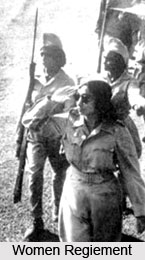 "… I want … a unit of brave Indian women to form a death-defying Regiment who will wield the sword which Rani of Jhansi wielded in India`s First War of Independence in 1857." - The great leader was the first to recognise the immense potentiality in Indian women hence the participation of women in Indian army became an event of sheer importance. He therefore, invited the participation of Women in Indian National Army, to put up an invincible resistance against the hostile colonizers, the British.
"… I want … a unit of brave Indian women to form a death-defying Regiment who will wield the sword which Rani of Jhansi wielded in India`s First War of Independence in 1857." - The great leader was the first to recognise the immense potentiality in Indian women hence the participation of women in Indian army became an event of sheer importance. He therefore, invited the participation of Women in Indian National Army, to put up an invincible resistance against the hostile colonizers, the British.
Subhas Bose voyaged for Berlin, from Calcutta in January 1941, to enter a secret alliance with Hitler against the common foe, the British. About a year and a half later he sailed by submarine to Tokyo. There he accepted responsibilities of Indian prisoners of war. These prisoners were escorted to Singapore to be trained into an army of emancipation. On January 1942, the Indian National Army (INA) came into existence, at Berlin. On July 9, 1943, Subhas Bose was elected as the Indian Independence League of Singapore. The League vowed to offer him the urgent finances and army personnel, as per as requirements. He demanded 300,000 soldiers, Rs 30,000,000, and "a unit of brave Indian women." for accomplishing in the mission. Hence, ushered in a new era, unfolding the gallantry of women, in Indian national army.
 ubhas Bose very promptly, beckoned the women members of the League, to enroll themselves with the Rani of Jhansi brigade. Subhas Bose also designed a Department of Women`s Affairs within the League and recruited Dr. Lakshmi Swaminathan as head. The "utter, absolute sincerity" of Subhash Chandra Bose in recognising the talent of Indian women within no time paved the way to usher in a new concept of involving women in Indian national army. The first wish of the department was to appoint women for the INA, but its ultimate destination was the achievement of equality for women. Subhas Bose urged Dr. Lakshmi and the women of Singapore to embrace the female freedom fighters in India as their ideal. Women`s bravery and commitment had very well been focused in the Satyagraha protests of Gandhi as well as in radical nationalism. In fact, to imbue the regiment with the Indian heritage of boldness, it was named after the Rani of Jhansi, the heroine of the First Indian War of Independence, the Revolt of 1857.
ubhas Bose very promptly, beckoned the women members of the League, to enroll themselves with the Rani of Jhansi brigade. Subhas Bose also designed a Department of Women`s Affairs within the League and recruited Dr. Lakshmi Swaminathan as head. The "utter, absolute sincerity" of Subhash Chandra Bose in recognising the talent of Indian women within no time paved the way to usher in a new concept of involving women in Indian national army. The first wish of the department was to appoint women for the INA, but its ultimate destination was the achievement of equality for women. Subhas Bose urged Dr. Lakshmi and the women of Singapore to embrace the female freedom fighters in India as their ideal. Women`s bravery and commitment had very well been focused in the Satyagraha protests of Gandhi as well as in radical nationalism. In fact, to imbue the regiment with the Indian heritage of boldness, it was named after the Rani of Jhansi, the heroine of the First Indian War of Independence, the Revolt of 1857.
The first Rani of Jhansi training camp was inaugurated under the direct guidance of Subhas Bose, near Singapore on October 22, 1943. Dr. Lakshmi Swaminathan, was conferred upon the military status of Captain Lakshmi. She became the in-charge of the regiment`s military and nursing sections. The seed sown back, thus gained a definite contour with this whilst making women in Indian national army an imperative part.
The stirring speech of Subhas Bose in Kuala Lumpur overwhelmed the women folk. Janaki Davar, a patriotic mind, donated her earrings for the war-fund of Subhas Bose. Her parents were annoyed with her act but she could manipulate them to invite Captain Lakshmi for tea. Lakshmi gave Janaki to fill up the application form for the regiment. When Janaki was seventeen, she rose to the prominence of a Rani (league-member). The Japanese and Indian press greeted this formation of INA. The three camps - at Singapore, Rangoon, and Bangkok - started consisting of 1,000 women recruits. Whereas a minority was furnished with nurse`s training, the maximum members the rest were molded into soldiers. The level of training was in keeping with the standards of male soldiers` rigorous training. The women in Indian national army, donned in caps, shirts, jodhpurs, breeches, and boots, resembled that of men.
 However, when it came to active participation in the war-front, the ranis , lagged a little behind. A contingent of women was channelised as a retreating army to Burma just as the Japanese were being pushed back from Imphal. By June of 1945 the ranis had retired to Singapore while Captain Lakshmi remained behind in the jungles of Burma to continue with her rescue operations. The ranis had a face-to-face meeting with their commander, Subhas Bose, for last time on August 14 , while they enacted a drama on the glorious life of the Rani of Jhansi.
However, when it came to active participation in the war-front, the ranis , lagged a little behind. A contingent of women was channelised as a retreating army to Burma just as the Japanese were being pushed back from Imphal. By June of 1945 the ranis had retired to Singapore while Captain Lakshmi remained behind in the jungles of Burma to continue with her rescue operations. The ranis had a face-to-face meeting with their commander, Subhas Bose, for last time on August 14 , while they enacted a drama on the glorious life of the Rani of Jhansi.
The British who returned to Burma and Malaya, to investigate on the members of the INA, were taken aback to witness the competence of women in Indian National Army. They were probably expecting, the familiar image of the shy, introvert and fragile Indian womanhood. Women in proper military uniform, saluting smartly, and proclaiming themselves as members of the Rani of Jhansi regiment, left the British spellbound.
It is evident, that the activities of the women in Indian National Army were carried outside India. It was reality that only a few of these ranis came back India after the war, but they had left their legacy of mind-blowing courage and sacrifice to the posterity of Indian womanhood.
Women in Indian national army remained immortal in legends or stories of their dauntless dedication. The history of the inclusion of women in Indian National Army, highlights the aura of genius, related to the meritorious Indian woman, who has the capability to become caring and loving, to dear ones, and to take up arms against the malignant enemy.






































